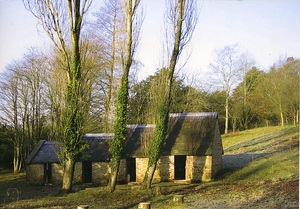This is an archive of the ArtCat Zine, 2007-2009. Please visit our new project, IDIOM.
Kurt W. Forster on the New Museum
Recommended in the most recent issue of Log, Any Corporation's journal of architecture and the contemporary city, is Kurt W. Forster's short text on SANAA's 2003 reimagining of the New Museum. Granted the suggestion of these observations may seem to come a bit late to readers who have witnessed the issue beaten to death earlier this year in the popular (if tedious) city media on occasion of the Museum's completion and opening, your correspondent here nonetheless begs you to overlook this timeliness or untimeliness with the following promise: Forster's piece offers what may have taken a year to become so articulate, that is, an inspired and critical look at the still curious new New Museum. To accomplish this, the critic brings forth some of the Museum's most demure furnishing, citing the serious decisions in the details: the joining of the walls to the cement colored resin floor with no dividing baseboard, the seamless integration of the exit signs and museum lights into the building's uniform structure and the generally compressed, nipped and tucked feeling of the entire building. But most extensively, Forster analyzes the Museum's whiteness, that thick coat of paint "rendered blinding by the electric illumination" that, to quote the author again, this time quoting Brian O'Doherty, acts like "a protective coat" to the museum, "recalling the white smock worn by those who need to handle things in a laboratory." In his analysis, the critic theorizes this whiteness as the germ of a move towards a certain 20th century commercial gallery exhibition culture (and a faith therein), clashing starkly with the art being championed here, an art of smaller, fragmented parts. Forster writes:
I am not raising an objection to white, in principle, but rather questioning its rationale in a museum context. It pertains to a a precise gallery culture, created for a particular kind of art, one from which the New Museum is allegedly trying to escape. White, as we know, is not a color, and only emerges as one of the presence of others. But this is precisely where the problem arises, for white is used in the New Museum as the dominant hue. It comes across as an article of faith rather than the tint of choice. And as such, white must dominate and be affirmed as a defining trait of the building itself. That much it does share with glass at the Glass Pavilion, but while glass can and will be forever changing through refraction, the white surfaces make for a static confining setting. Add to this the steep angle of daylight falling into some of the galleries, as well as their customary artificial illumination, and the result will be hermetic in the extreme.
Log 12, the journal's Spring/Summer 2008 issue, is still available in several bookstores across Brooklyn and Manhattan.
ZINE
HOME
TIPS / COMMENTS
CATEGORIES
CONTRIBUTORS
- Greg Afinogenov
- B. Blagojevic
- Adda Birnir
- Susannah Edelbaum
- Julie Fishkin
- Paddy Johnson
- Jessica Loudis
- Christopher Reiger
- Andrew Robinson
- Peter J. Russo
- Blythe Sheldon
- S.C.Squibb
- Hrag Vartanian

